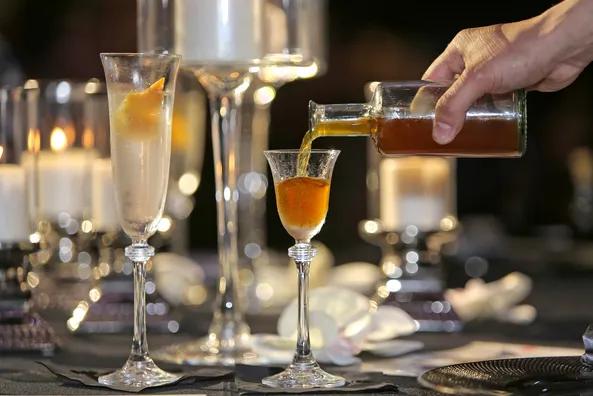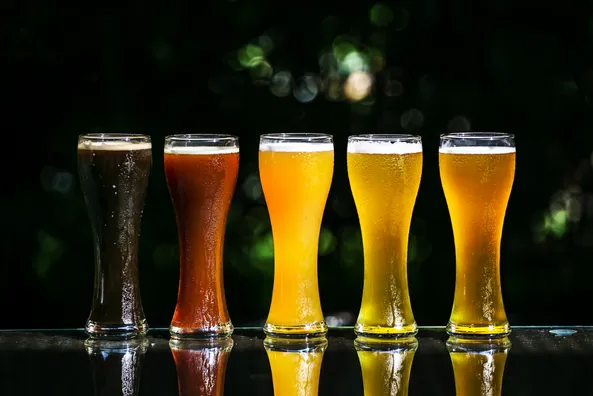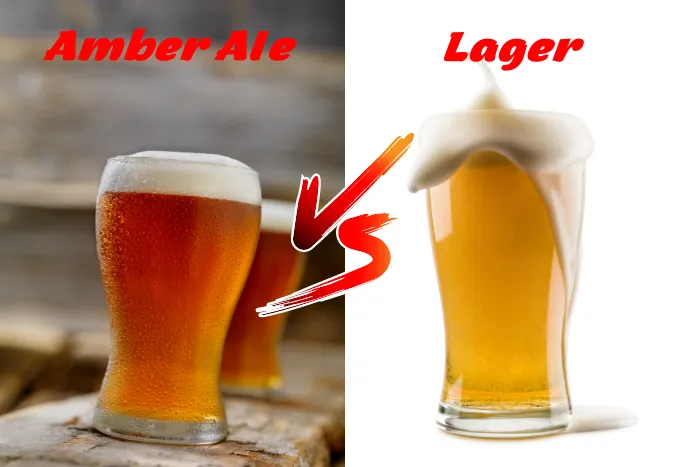The discussion between lager and amber beer can often be intense, with both varieties having different roots, components, taste profiles, and health effects. Both styles have different origins, ingredients, flavor profiles, and health effects, so choosing a beer style is difficult.
We’ll compare lager and amber beers’ histories, fermentation processes, color profiles, and more so readers can choose a beer wisely. We’ll also provide a list of popular brands for each category, so our readers know exactly where to start.
Table of Contents:
- Lager vs Amber: Origins and History
- Ingredients and Fermentation Process
- Flavor Profile and Mouthfeel
- Color, Alcohol Content, IBU, and Health Impact
- Popular Brands to Try
- FAQs in Relation to Lager vs Amber
- Conclusion
Origins and History of Lager

The invention of lager beer can be traced back to Bavaria, Germany, in the Middle Ages. Lagers are bottom-fermented beers that use a type of yeast called Saccharomyces pastorianus.
This yeast ferments at cooler temperatures than other types of beer and is responsible for the crisp flavor and light color associated with lagers.
Historically, lagers were popular among German brewers due to their long shelf life and ability to withstand hot summers without spoiling quickly.
Origins and History of Amber
Amber brews have a much more limited past than lagers, appearing only since the mid-1800s. Amber ales are top-fermented beers featuring a blend of Munich, Vienna, Caramel, and Crystal malt that give the beer its amber hue and sweet caramel flavor.
These malts also impart a sweet caramel flavor that balances the bitterness from hops used in brewing amber ales.
Lager and amber beers have played an important role in beer culture throughout history. Lager has become one of the most popular styles worldwide due to its easy-drinking nature.
At the same time, ambers offer more complexity through their unique malty flavors and aromas, making them ideal for craft beer enthusiasts looking for something new or interesting. Both lager and amber beers remain popular today, still captivating drinkers with their distinct flavors and aromas.
Ingredients Used in Lager
The flavor and texture of lager beers is largely determined by the combination of barley malt, hops, water, and yeast used in its production. Lager beers are typically made with barley malt, hops, water, and yeast.
The use of lager yeast helps create a crisp finish that makes this style of beer popular among craft brewers. Barley malt is what gives lagers their color and body while hops provide bitterness to balance out the sweetness from the malt. Water also plays an important part as it affects how much sugar can be extracted from the grains during brewing.
Ingredients Used in Amber
Amber beers use similar ingredients but differ in some respects; they tend to have more roasted malts, giving them their signature amber hue and nutty flavor profile. Hops are used for aroma and bittering purposes; however, amber ales usually contain fewer hops than lagers due to their sweeter taste profiles. Yeast is also used but tends to be different varieties, such as ale or wheat strains which help create more fruity aromas than those found in lagers.
Fermentation Process of Lager and Amber
The fermentation process for both types of beer involves converting sugars into alcohol using yeast cells over time at specific temperatures depending on whether you’re making a lager or an ale beer (ales ferment at higher temperatures).
During this stage, carbon dioxide gas is produced, which helps give these beers their bubbly texture when poured into glasses. Fermentation can take two weeks to several months, depending on the beer. All-grain recipes take longer because they require extra steps to remove starches before fermentation.
The ingredients and fermentation process of lager and amber beers can vary greatly, but the result is always a unique flavor profile that all can enjoy. Let’s investigate the distinct gustatory and tactile experiences of both lager and amber beers to gain a better appreciation for them.
Taste of Lager Beer
Lager beer is known for its light, crisp flavor. It has a light to medium body with low bitterness and sweetness levels. Its aroma is usually faint but may have hints of malt or hops, depending on the style.
Lagers are often characterized by their clean finish and lack of strong aftertaste. This brew is great for individuals who desire to savor a refreshing beer without being overpowered by potent tastes.
Taste of Amber Beer
On the other hand, Amber beers offer a richer flavor profile than lagers. They typically feature malty notes such as caramel or toast that balance out the hoppy bitterness present in most amber ales.
The body tends to be fuller than lagers and can range from light-medium to full-bodied depending on the style of amber ale chosen. Aroma-wise, these brews stand out more due to their greater hop content than lagers.
The flavor profile and mouthfeel of lager and amber beers can vary greatly, but the overall characteristics are quite distinct. Moving on to color, alcohol content, IBU, and health impact – let’s take a closer look at how these factors differ between lagers and ambers.
Color Comparison of Lager and Amber Beer

The color of lager and amber beers can vary greatly, depending on the type. Lagers usually have a paler tone, varying from light yellow to golden. Ambers are darker and may appear anywhere from deep copper to reddish-brown. The darkness of an amber beer is usually determined by how long it has been aged or stored for fermentation.
Alcohol Content Comparison of Lager and Amber Beer
The alcohol content also varies between lagers and ambers. Lagers tend to be less potent than ambers, generally having an ABV of 4%, compared with the 5-6% found in ambers – making them more suitable for long drinking sessions.
IBU Comparison of Lager and Amber Beer
IBU stands for International Bitterness Unit and measures the bitterness level of a beer based on its hop content. Lagers generally have a low IBU rating, while ambers often have higher IBUs due to their increased hop levels during brewing.
An average lager might have an IBU rating from 10 to 20, while the hop content of ambers can result in IBUs ranging from 20 to 40 or higher.
Finally, potential medical ramifications should be considered when selecting which beer to consume responsibly at any given moment. Consuming too much alcohol can lead to dehydration and other negative side effects; however, moderate consumption can offer some health benefits, such as improved heart health or reduced risk of stroke over time – so drink up but do so responsibly.
Popular Brands of Lagers
When it comes to lager beer, there are a plethora of brands that can be tried. From the traditional Bud and Coors to small-batch Yuengling or Sam Adams, there’s something for all beer enthusiasts.
Try Heineken or Beck’s Premier Light for those looking for a more flavorful option. If you’re feeling adventurous, go for an imported beer like Corona or Stella Artois. No matter your flavor preference, you’ll be sure to find a beer that suits your palate.
Popular Brands of Ambers
If amber beers are more up your alley, look no further than New Belgium Fat Tire or Samuel Smith’s Nut Brown Ale. Both offer a delicious malty flavor with hints of caramel and chocolate notes in the finish. For those who prefer darker beers without being too heavy on the palate, Sierra Nevada Torpedo Extra IPA is always a good choice, and Founders All Day IPA has an intense citrus aroma with subtle malt flavors.
Other great options include Stone Enjoy By 04-20-17 Unfiltered IPA and Lagunitas Maximus Imperial India Pale Ale if you want something extra hoppy.
FAQs in Relation to Lager vs Amber
What is the difference between lager and amber?
Lager and amber beers are both ales, but there is a distinct difference between them. Lagers are brewed with bottom-fermenting yeast at cooler temperatures than ales, which results in a crisper taste.
Amber beers have more complex flavors like caramel or toffee due to top-fermenting yeast and higher fermentation temperatures. Both lagers and ambers have unique characteristics that make them popular among beer drinkers of all types.
Which is stronger amber or lager?
Amber and lager are both beer styles, but they have different strengths. Lagers have 3.5–5% ABV, while amber beers have 4–6% ABV and a medium body. Ambers have a higher ABV than lagers, but their potency depends on their brewing process and formula.
Is Amber lighter than lager?
Amber ales are generally considered lighter in color and body than lagers. They have a caramelized flavor and darker color due to longer kilning. Lager yeast ferments at cooler temperatures, creating a crisper taste with less fruity or floral notes than its ale counterpart. Due to yeast fermenting malt sugar, amber ales have higher alcohol content. In conclusion, amber ales are lighter than lagers in color and body but may have more alcohol.
What is the difference between ale and amber?
Ale and amber are both types of beer, but they have distinct differences. Ale is a brew concocted with top-fermenting yeast, yielding fragrant or piquant tastes. Amber beers are typically brewed with bottom-fermenting yeasts that produce maltier and nuttier flavors.
Additionally, ales tend to be stronger in alcohol content than ambers. Ales range from light gold to dark brown, while amber beers are golden copper to reddish brown. Ales also tend to be hoppier than ambers due to their higher hop content during brewing.
Conclusion
In conclusion, lager and amber beers are two distinct beer styles with unique flavor profiles. Both styles offer distinct experiences, allowing drinkers to choose between a lighter lager or darker amber ale. Lagers tend to be lighter in color with a milder taste, while ambers are darker in hue with more pronounced flavors. Ultimately, it’s the imbiber’s prerogative to pick between a chill lager or an aromatic amber; they opt for their own decision.
Discover the best lagers and ambers with our expert beer reviews to quench your thirst. Learn about the latest brewing equipment, subscription services, and techniques for making great-tasting craft beers at home!
